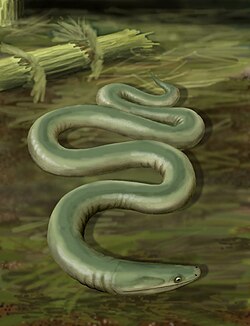IntroductionThe Carboniferous (/ˌkɑːrbəˈnɪfərəs/ KAR-bə-NIF-ər-əs) is a geologic period and system of the Paleozoic that spans 60 million years from the end of the Devonian Period 358.9 Ma (million years ago) to the beginning of the Permian Period, 298.9 Ma. In North America, the Carboniferous is often treated as two separate geological periods, the earlier Mississippian and the later Pennsylvanian. The name Carboniferous means "coal-bearing", from the Latin carbō ("coal") and ferō ("bear, carry"), and refers to the many coal beds formed globally during that time. The first of the modern "system" names, it was coined by geologists William Conybeare and William Phillips in 1822, based on a study of the British rock succession. Carboniferous is the period during which both terrestrial animal and land plant life was well established. Stegocephalia (four-limbed vertebrates including true tetrapods), whose forerunners (tetrapodomorphs) had evolved from lobe-finned fish during the preceding Devonian period, became pentadactylous during the Carboniferous. The period is sometimes called the Age of Amphibians because of the diversification of early amphibians such as the temnospondyls, which became dominant land vertebrates, as well as the first appearance of amniotes including synapsids (the clade to which modern mammals belong) and sauropsids (which include modern reptiles and birds) during the late Carboniferous. Due to the raised atmospheric oxygen level, land arthropods such as arachnids (e.g. trigonotarbids and Pulmonoscorpius), myriapods (e.g. Arthropleura) and insects (e.g. Meganeura) also underwent a major evolutionary radiation during the late Carboniferous. Vast swaths of forests and swamps covered the land, which eventually became the coal beds characteristic of the Carboniferous stratigraphy evident today. The later half of the period experienced glaciations, low sea level, and mountain building as the continents collided to form Pangaea. A minor marine and terrestrial extinction event, the Carboniferous rainforest collapse, occurred at the end of the period, caused by climate change. (Full article...) Selected natural world article Virus particles (known as virions) consist of two or three parts: i) the genetic material made from either DNA or RNA, long molecules that carry genetic information; ii) a proteincoat that protects these genes; and in some cases iii) an envelope of lipids that surrounds the protein coat when they are outside a cell. The shapes of viruses range from simplehelical and icosahedral forms to more complex structures. The average virus is about one one-hundredth the size of the average bacterium. The origins of viruses in the evolutionary history of life are unclear: some may have evolved from plasmids—pieces of DNA that can move between cells—while others may have evolved from bacteria. Viruses are considered by some to be a life form, because they carry genetic material, reproduce, and evolve through natural selection. However they lack key characteristics (such as cell structure) that are generally considered necessary to count as life, so whether or not viruses are truly alive is controversial. (see more...) Did you know...
Need help?Do you have a question about Abyssal/Portal:Carboniferous that you can't find the answer to? Consider asking it at the Wikipedia reference desk. Selected image
Selected science, culture, or economics article
Paleontology or palaeontology (/ˌpeɪliɒnˈtɒlədʒi, ˌpæli-, -ən-/) is the scientific study of prehistoric life. It includes the study of fossils to determine organisms' evolution and interactions with each other and their environments (their paleoecology). As a "historical science" it attempts to explain causes rather than conduct experiments to observe effects. Paleontological observations have been documented as far back as the 5th century BC. The science became established in the 18th century as a result of Georges Cuvier's work on comparative anatomy, and developed rapidly in the 19th century. The term itself originates from Greek: παλαιός (palaios) meaning "old, ancient," ὄν, ὀντ- (on, ont-), meaning "being, creature" and λόγος (logos), meaning "speech, thought, study".
Paleontology lies on the border between biology and geology. It now uses techniques drawn from a wide range of sciences, including biochemistry, mathematics and engineering. Use of all these techniques has enabled paleontologists to discover much of the evolutionary history of life, almost all the way back to when Earth became capable of supporting life, about 3,800 million years ago. As knowledge has increased, paleontology has developed specialized sub-divisions, some of which focus on different types of fossil organisms while others study ecology and environmental history, such as ancient climates. Body fossils and trace fossils are the principal types of evidence about ancient life, and geochemical evidence has helped to decipher the evolution of life before there were organisms large enough to leave fossils. (see more...) GeochronologyEpochs - Mississippian - Pennsylvanian Landmasses - Gondwanaland - Laurasia - Pangaea Fossil sites - Bear Gulch Limestone - Hamilton Quarry - Mazon Creek fossil beds Researchers - Alfred Sherwood Romer
SubcategoriesQuality ContentFeatured Carboniferous articles - Amphibian Things you can doRelated contentAssociated WikimediaThe following Wikimedia Foundation sister projects provide more on this subject:
|




















